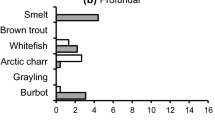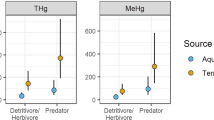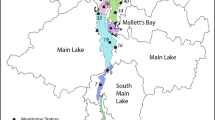Abstract
Mercury is a neurotoxic pollutant and contamination in remote ecosystems due to atmospheric mercury deposition coupled with watershed characteristics that influence mercury bioavailability. Biological interactions that affect mercury bioaccumulation are especially relevant as fish assemblages change in response to species introductions and lake management practices. We studied the influence of shifting food web dynamics on mercury in fisheries of Little Moose Lake in the southwestern Adirondack Mountains of New York, USA. Annual removal of non-native Smallmouth Bass (Micropterus dolomieu) has been used as a management strategy since 2000 to restore the native fish assemblage and food web in favor of Lake Trout (Salvelinus namaycush). Changes in total mercury, stable carbon (13C/12C) and nitrogen (15N/14N) isotopes, and growth were evaluated for Lake Trout and Smallmouth Bass. Growth rates increased for both predators and trophic position increased for Lake Trout post-removal. Mercury concentrations in Lake Trout increased over the 16-year study period influenced by a diet shift from invertebrates to higher trophic level prey fish, regardless of increased growth. Smallmouth Bass mercury concentrations decreased with compensatory growth from a reduced population size. These contrasting trends indicate that changes in mercury deposition were not the primary driver for mercury bioaccumulation responses in Little Moose Lake. Stable isotope values changed for both predators and for several lower trophic level organisms, likely reflecting changes in nutrient cycling and/or inputs. Our findings emphasize the potential role of fisheries management on whole-lake and predatory fish responses to mercury contamination in temperate lakes.




Similar content being viewed by others
References
Benoit JM, Gilmour CC, Heyes A, Mason RP, Miller CL (2003) Geochemical and biological controls over methylmercury production and degradation in aquatic ecosystems. ACS Symp Ser 835:262–297
Bloom NS (1992) On the chemical form of mercury in edible fish and marine invertebrate tissue. Can J Fish Aquat Sci 49:1010–1017
Braaten HFV, de Wit HA, Larssen T, Poste AE (2018) Mercury in fish from Norwegian lakes: the complex influence of aqueous organic carbon. Sci Total Environ 627:341–348
Brown PJ, Josephson DC, Krueger CC (2000) Summer habitat use by introduced smallmouth bass in an oligotrophic Adirondack lake. J Freshw Ecol 15:135–144
Downs SG, Macleod CL, Lester JN (1998) Mercury in precipitation and its relation to bioaccumulation in fish: a literature review. Water Air Soil Pollut 108:149–187
Driscoll CT et al. (2007) Mercury contamination in forest and freshwater ecosystems in the Northeastern United States. BioScience 57:17–28
Driscoll CT, Driscoll KM, Fakhraei H, Civerolo K (2016) Long-term temporal trends and spatial patterns in the acid-base chemistry of lakes in the Adirondack region of New York in response to decreases in acidic deposition. Atmos Environ 146:5–14
Driscoll CT, Mason RP, Chan HM, Jacob DJ, Pirrone N (2013) Mercury as a global pollutant: sources, pathways, and effects. Environ Sci Technol 47:4967–4983
Driscoll CT, Yan C, Schofield CL, Munson R, Holsapple J (1994) The mercury cycle and fish in the Adirondack Lakes. Environ Sci Technol 28:A136–A143
Duran J et al. (2016) Climate change decreases nitrogen pools and mineralization rates in northern hardwood forests. Ecosphere 7:1–13
Eagles-Smith CA et al. (2016) Spatial and temporal patterns of mercury concentrations in freshwater fish across the Western United States and Canada. Sci Total Environ 568:1171–1184
Eagles-Smith CA, Suchanek TH, Colwell AE, Anderson NL, Moyle PB (2008) Changes in fish diets and food web mercury bioaccumulation induced by an invasive planktivorous fish. Ecol Appl 18:A213–A226
Evers DC et al. (2007) Biological mercury hotspots in the northeastern United States and southeastern Canada. BioScience 57:29–43
Fitzgerald WF, Engstrom DR, Mason RP, Nater EA (1998) The case for atmospheric mercury contamination in remote areas. Environ Sci Technol 32:1–7
French TD et al. (2014) Dissolved organic carbon thresholds affect mercury bioaccumulation in Arctic lakes. Environ Sci Technol 48:3162–3168
Gerson JR, Driscoll CT (2016) Is mercury in a remote forested watershed of the Adirondack mountains responding to recent decreases in emissions? Environ Sci Technol 50:10943–10950
Gothberg A (1983) Intensive fishing—a way to reduce the mercury level in fish. Ambio 12:259–261
Groffman PM et al. (2018) Nitrogen oligotrophication in northern hardwood forests. Biogeochemistry 141:523–539
Hebert CE, Weseloh DVC (2006) Adjusting for temporal change in trophic position results in reduced rates of contaminant decline. Environ Sci Technol 40:5624–5628
Hutcheson MS et al. (2014) Temporal and spatial trends in freshwater fish tissue mercury concentrations associated with mercury emissions reductions. Environ Sci Technol 48:2193–2202
Johnson BM, Lepak JM, Wolff BA (2015) Effects of prey assemblage on mercury bioaccumulation in a piscivorous sport fish. Sci Total Environ 506:330–337
Kerin EJ, Gilmour CC, Roden E, Suzuki MT, Coates JD, Mason RP (2006) Mercury methylation by dissimilatory iron-reducing bacteria. Appl Environ Microbiol 72:7919–7921
Lepak JM et al. (2012a) Manipulation of growth to reduce mercury concentrations in sport fish on a whole-system scale. Can J Fish Aquat Sci 69:122–135
Lepak JM, Hooten MB, Johnson BM (2012b) The influence of external subsidies on diet, growth and Hg concentrations of freshwater sport fish: implications for management and fish consumption advisories. Ecotoxicology 21:1878–1888
Lepak JM, Kraft CE, Weldel BC (2006) Rapid food web recovery in response to removal of an introduced apex predator. Can J Fish Aquat Sci 63:569–575
Lepak JM, Robinson JM, Kraft CE, Josephson DC (2009) Changes in mercury bioaccumulation in an apex predator in response to removal of an introduced competitor. Ecotoxicology 18:488–498
Lescord GL, Johnson TA, Branfireun BA, Gunn JM (2018) Percentage of methylmercury in the muscle tissue of freshwater fish varies with body size and age and among species. Environ Toxicol Chem 37:2682–2691
Logan JM, Jardine TD, Miller TJ, Bunn SE, Cunjak RA, Lutcavage ME (2008) Lipid corrections in carbon and nitrogen stable isotope analysis: comparison of chemical extraction and modelling methods. J Anim Ecol 77:838–846
Mao H, Ye Z, Driscoll CT (2017) Meteorological effects on Hg wet deposition in a forested site in the Adirondack region of New York during 2000–2015. Atmos Environ 168:90–100. https://doi.org/10.1016/j.atmosenv.2017.08.058
Minagawa M, Wada E (1984) Stepwise enrichment of N-15 along food-chains—further evidence and the relation between Delta-N-15 and animal age. Geochim Cosmochim Acta 48:1135–1140
Pirrone N et al. (2010) Global mercury emissions to the atmosphere from anthropogenic and natural sources. Atmos Chem Phys 10:5951–5964
Sabo RD et al. (2016) Watershed-scale changes in terrestrial nitrogen cycling during a period of decreased atmospheric nitrate and sulfur deposition. Atmos Environ 146:271–279
Scheulhammer AM, Meyer MW, Sandheinrich MB, Murray MW (2007) Effects of environmental methylmercury on the health of wild birds, mammals, and fish. Ambio 36:12–18
Scudder Eikenberry BC, Riva-Murray K, Knights CD, Journey CA, Chasar LC, Brigham ME, Bradley PM (2015) Optimizing fish sampling for fish-mercury bioaccumulation factors. Chemosphere 135:467–473
Simonin HA, Loukmas JJ, Skinner LC, Roy KA (2008) Lake variability: Key factors controlling mercury concentrations in New York State fish. Environ Pollut 154:107–115
Simonin HA, Loukmas JJ, Skinner LC, Roy KM, Paul EA (2009) Trends in Mercury Concentrations in New York State Fish. Bull Environ Contam Toxicol 83:214–218
Thomas SM, Kiljunen M, Malinen T, Eloranta AP, Amundsen PA, Lodenius M, Kahilainen KK (2016) Food-web structure and mercury dynamics in a large subarctic lake following multiple species introductions. Freshw Biol 61:500–517
UNEP (2013) Global mercury assessment 2013: sources, emissions, releases and environmental transport. UNEP Chemicals Branch, Geneva, Switzerland. http://www.unep.org/PDF/PressReleases/GlobalMercuryAssessment2013.pdf
United States Environmental Protection Agency (1996) Method 1669. USEPA, Office of Water, Office of Science and Technology, Engineering and Analysis Division (4303), Washington D.C. 20460
United States Environmental Protection Agency (1998) Method 7473. USEPA, Office of Water, Office of Science and Technology, Engineering and Analysis Division (4303), Washington D.C. 20460
United States Environmental Protection Agency (2002) Method 1631, revision E. USEPA, Office of Water, Office of Science and Technology, Engineering and Analysis Division (4303), Washington D.C. 20460
United States Environmental Protection Agency (2007) Method 1630. USEPA, Office of Water, Office of Science and Technology, Engineering and Analysis Division (4303), Washington D.C. 20460
Vander Zanden MJ, Rasmussen J JB (1999) Primary consumer delta C-13 and delta N-15 and the trophic position of aquatic consumers. Ecology 80:1395–1404
Vander Zanden MJ, Rasmussen JB (2002) Food web perspectives on studies of bass populations in north-temperate lakes Am Fish Soc Symp 31:173–184
Verta M (1990) Changes in fish mercury concentrations in an intensively fished lake. Can J Fish Aquat Sci 47:1888–1897
Waller K, Driscoll C, Lynch J, Newcomb D, Roy K (2012) Long-term recovery of lakes in the Adirondack region of New York to decreases in acidic deposition. Atmos Environ 46:56–64
Weidel BC, Josephson DC, Kraft CE (2007) Littoral fish community response to smallmouth bass removal from an Adirondack lake. Trans Am Fish Soc 136:778–789
Yu X, Driscoll CT, Huang J, Holsen TM, Blackwell BD (2013) Modeling and mapping of atmospheric mercury deposition in Adirondack Park, New York. Plos ONE 8:e59322. https://doi.org/10.1371/journal.pone.0059322
Zhang YX et al. (2016) Observed decrease in atmospheric mercury explained by global decline in anthropogenic emissions. Proc Natl Acad Sci USA 113:526–531
Zhou H et al. (2017) Atmospheric mercury temporal trends in the Northeastern United States from 1992 to 2014: are measured concentrations responding to decreasing regional emissions? Environ Sci Technol Lett 4:91–97
Acknowledgements
This research was supported by the New York State Energy and Research Development Authority. We appreciate our colleagues at Syracuse University especially the Center for Environmental Systems Engineering Laboratory Manager, M. Montesdeoca as well as A. Shaw, S. Boucher, G. Millard, J. Gerson, N. Glick, N. LoRusso, T. Wang and M. Persson for their help with field and laboratory work. Thanks to E. Randall and B. Marcy-Quay at Cornell University for facilitating field work, providing data and valuable insights to this research. We also appreciate comments and feedback provided by reviewers on a previous version of this manuscript.
Funding
This study was funded by New York State Energy Research and Development Authority contract #34357.
Author information
Authors and Affiliations
Corresponding author
Ethics declarations
Conflict of interest
The authors declare that they have no conflict of interest.
Ethical approval
All applicable international, national, and/or institutional guidelines for the care and use of animals were followed.
Additional information
Publisher’s note Springer Nature remains neutral with regard to jurisdictional claims in published maps and institutional affiliations.
Rights and permissions
About this article
Cite this article
Taylor, M.S., Driscoll, C.T., Lepak, J.M. et al. Temporal trends in fish mercury concentrations in an Adirondack Lake managed with a continual predator removal program. Ecotoxicology 29, 1762–1773 (2020). https://doi.org/10.1007/s10646-019-02156-5
Accepted:
Published:
Issue Date:
DOI: https://doi.org/10.1007/s10646-019-02156-5




